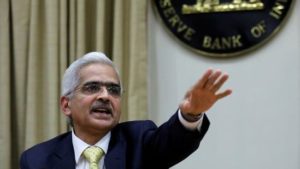
Reserve Bank of India (RBI) will conduct fine-tuning operations to manage unanticipated and one-off liquidity flows to ensure balanced liquidity conditions in the system, Governor Shaktikanta Das said on Tuesday.
The Governor said that in the monetary policy statement of August 6, he had set out a road map for the gradual restoration of the Variable Rate Reverse Repo (VRRR) auction as the main operation under the revised liquidity management framework announced on February 6, 2020.
In order to facilitate this process as markets settle down to regular timings and functioning and liquidity operations normalise, Das said, “the RBI will also conduct fine-tuning operations from time to time as needed to manage unanticipated and one-off liquidity flows so that liquid conditions in the system evolve in a balanced and evenly distributed manner”.
He was speaking at a conference organised by Fixed Income Money Market and Derivatives Association of India (FIMMDA) and Primary Dealers’ Association of India (PDAI).
Das said it is also an opportune time to consider new instruments to facilitate hedging of long-term interest rate and re-investment risk by market participants such as insurance companies, provident and pension funds and corporates.
“On its part, the Reserve Bank will endeavour to ensure adequate liquidity in the G-Sec (Government Securities) market as an integral element of its effort to maintain comfortable liquidity conditions in the system,” the Governor said.
He said government securities are a distinct asset class and it is important to appreciate the role the G-Sec market plays in the overall macro interest rate environment of the economy.
Globally, the G-Sec market is predominantly an institutional market, with the major participants being banks and long-term investors, including investment funds, insurance funds, retirement funds.
Different G-Sec instruments are highly substitutable, the only differentiating factor being tenor of instruments, he said adding, “this is one of the reasons why the G-Sec yield curve may be viewed as a public good, as I have been emphasising”.
“Monetary transmission is fundamentally linked to an efficient G-Sec market in any market economy,” Das added.
Noting that RBI has taken several important measures to develop the G-Sec market, he said issuances of G-Secs are made in different maturity buckets, enabling the formation of a yield curve up to 40 years.
A yield curve plots yields or interest rates of government bonds having equal credit quality but different maturity dates.
Regulatory provisions for issuance of Separate Trading of Registered Interest and Principal of Securities (STRIPS) have also been made to facilitate the development of a zero-coupon yield curve and to attract retail investors to the G-Sec market, Das said.
“Going forward, it would be desirable for RBI and the market bodies like FIMMDA and PDAI to work together to popularise the STRIPS instrument further,” he added.
According to him, RBI has continuously engaged in developing state-of-the-art infrastructure relating to trading and post-trade services, including settlement, reporting and timely dissemination of traded information, both in outright and repo markets.
“I can say with all humility that the infrastructure of the G-Sec market in India can be regarded as cutting edge in terms of sophistication,” he said.
Das said RBI’s multi-faceted role as monetary policy authority, manager of systemic liquidity, government debt manager, regulator of interest rate and foreign exchange markets, regulator of payment and settlement systems and overseer of financial stability makes the G-Sec market critical for the effective discharge of these responsibilities.
With the development of the domestic financial markets and deregulation of interest rates, effective transmission of monetary policy impulses relies on the G-Sec market being deep and liquid to create the intended impact on interest rates by linking expectations of future short-term rates to current long-term rates, he said.
He said a well-functioning G-Sec market ensures efficient discharge of the public debt management function.
“In the wake of the pandemic, when fiscal response resulted in a sharp increase in government borrowing, the market operations conducted by RBI not only ensured non-disruptive implementation of the borrowing programme but also facilitated the stable and orderly evolution of the yield curve,” he said.
Monetary policy, G-Sec market regulation and public debt management, therefore, need to be conducted in close coordination, and the primary focus of such coordination is the G-Sec market, Das pointed out.
Notwithstanding the robust evolution of the G-Sec market in India, Das said there is scope for further development to remain in sync with the emerging requirements.
He said the secondary market liquidity, as measured by the turnover ratio is found to be relatively low on several occasions and tends to remain concentrated in a few securities and tenors.
The yield curve accordingly displays kinks, reflecting the liquidity premium commanded by select securities/ tenors, he added.
“To a certain extent, this is the result of the market microstructure in India, dominated as it is by ‘buy and hold’ and ‘long only’ investors. We need to develop a yield curve that is liquid across tenors,” the Governor said.
Further, Das said expansion of the investor base is key to further development of the market and RBI and the government are making efforts to enable international settlement of transactions in G-Secs through International Central Securities Depositories (ICSDs).
“Once operationalised, this will enhance access of non-residents to the G-Secs market as will the inclusion of Indian G-Secs in global bond indices, for which efforts are ongoing,” Das said.
While mentioning that COVID has impacted the global economy, Das said while there are signs of recovery, “we are not yet out of the woods”.
The sudden shock delivered by the pandemic called for swift and decisive policy responses by all the central banks.
RBI too responded swiftly and undertook several conventional, unconventional and innovative measures in the realms of monetary policy, liquidity support and regulation, he said. PTI HV RAM




 Driving Naari Programme launched in Chandigarh
Driving Naari Programme launched in Chandigarh






























